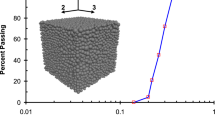Abstract
The aim of this paper is to present an overall model for the study of resin infusion based processes, in particular, the impregnation of a liquid resin through dry deformable fibrous reinforcements. This model can be appliedto a wide range of activities in many fields of engineering. Here, our approach based on a monolithic formulation in a level-set framework allows to strongly couple a Stokes-Darcy flow in low permeability media undergoing finite strains. The Stokes-Darcy coupled problem is solved using a mixed velocity-pressure formulation stabilized by a multi-scale method. A key feature of our approach is the fluid-solid interaction leading to couple a fluid/porous flow to a non-linear solid mechanics formulation. The interaction phenomenon due to the resin flow in the orthotropic highly compressible preform is based on both Terzaghi’s law and on explicit relation expressing permeability as function of porosity in finite strains mechanical framework. Finally, simulations of industrial design parts are performed to illustrate the abilities of our approach and the relevance of this fluid/porous-solid mechanics coupled problem for composite material process simulations.











Similar content being viewed by others
Notes
References
Abouorm L, Blais M, Moulin N, Bruchon J, Drapier S (2014) A robust monolithic approach for resin infusion based process modelling. Key Eng Mater 611-612:306–315
Abouorm L, Moulin N, Bruchon J, Drapier S (2013) Monolithic Approach of Stokes-Darcy Coupling for LCM Process Modelling. Key Eng Mater 554-557:447–455
Abouorm L, Troian R, Drapier S, Bruchon J, Moulin N (2014) Stokes-darcy coupling in severe regimes using multiscale stabilisation for mixed finite elements: monolithic approach versus decoupled approach. Eur J of Comput Mech 23(3-4): 113–137
Arnold DN, Brezzi F, Fortin M (1984) A stable finite element for the stokes equations. Calcolo 21 (4):337–344
Badia S, Codina R (2009) Unified stabilized finite element formulations for the stokes and the darcy problems. SIAM J Numer Anal 47(3):1971–2000
Badia S, Codina R (2010) Stabilized continuous and discontinuous galerkin techniques for darcy flow. Comput Methods Appl Mech Eng 199(2528):1654–1667
Badia S, Quaini A, Quarteroni A (2009) Coupling Biot and NavierStokes equations for modelling fluidporoelastic media interaction. J Comput Phys 228(21):7986–8014
Beavers GS, Joseph DD (1967) Boundary conditions at a naturally permeable wall. J Fluid Mech 30(01):197–207
Besson J, Foerch R (1997) Large scale object-oriented finite element code design. Comput Methods Appl Mech Eng 142(1):165–187
Bruchon J, Digonnet H, Coupez T (2009) Using a signed distance function for the simulation of metal forming processes: Formulation of the contact condition and mesh adaptation. From a Lagrangian approach to an Eulerian approach. International Journal for Numerical Methods in Engineering 78(8)
Carman PC (1937) Fluid Flow Through Granular Beds. Trans Inst Chem Eng 15:150–166
Celle P, Drapier S, Bergheau JM (2008) Numerical aspects of fluid infusion inside a compressible porous medium undergoing large strains. Revue européenne de mécanique numérique. Resin Infusion-Based Processes Simulation 17(5-6-7):819–827
Celle P, Drapier S, Bergheau JM (2008) Numerical modelling of liquid infusion into fibrous media undergoing compaction. Eur J Mech A Solids 27(4):647–661
Dereims A, Drapier S, Bergheau JM, de Luca P (2015) 3d robust iterative coupling of Stokes, Darcy and solid mechanics for low permeability media undergoing finite strains. Finite Elem Anal Des 94:1–15
Discacciati M (2005) Iterative Methods for Stokes/Darcy Coupling. Domain Decomposition Methods in Science and Engineering, vol 40. Springer, Berlin Heidelberg, pp 563–570
Discacciati M, Miglio E, Quarteroni A (2002) Mathematical and numerical models for coupling surface and groundwater flows. Appl Numer Math 43(12):57–74
Govignon Q, Bickerton S, Kelly PA (2010) Simulation of the reinforcement compaction and resin flow during the complete resin infusion process. Compos A: Appl Sci Manuf 41(1):45–57
Gutowski TG, Morigaki T, Cai Z (1987) The Consolidation of Laminate Composites. J Compos Mater 21(2):172–188
Masud A, Hughes T (2002) A stabilized mixed finite element method for darcy flow. Comput Methods Appl Mech Eng 191(39):4341–4370
Nunez R (2009) Problématique de la mesure de la perméabilité transverse de preformes fibreuses pour la fabrication de structures composites. Ph.D. thesis, École des Mines de Saint- Étienne
Osher S, Fedkiw RP (2001) Level Set Methods: An Overview and Some Recent Results. J Comput Phys 169(2):463–502
Ouahbi T, Saouab A, Brard J, Ouagne P, Chatel S (2007) Modelling of hydro-mechanical coupling in infusion processes. Compos A: Appl Sci Manuf 38(7):1646–1654
Pacquaut G, Bruchon J, Moulin N, Drapier S (2012) Combining a level-set method and a mixed stabilized p1/p1 formulation for coupling stokes-darcy flows. Int J Numer Methods Fluids 69(2):459–480
Sussman M, Smereka P, Osher S (1994) A Level Set Approach for Computing Solutions to Incompressible Two-Phase Flow. J Comput Phys 114(1):146–159
Terzaghi K (1956) Soil Mechanics in Engineering Practice. John Wiley and Sons
Zienkiewicz OC, Taylor RL (2005) The finite element method for solid and structural mechanics. Butterworth-Heinemann, Amsterdam; Boston
Acknowledgements
The authors would like to thank Hexcel Reinforcements Footnote 1 for its support to the present work.
Author information
Authors and Affiliations
Corresponding author
Rights and permissions
About this article
Cite this article
Blais, M., Moulin, N., Liotier, PJ. et al. Resin infusion-based processes simulation : coupled Stokes-Darcy flows in orthotropic preforms undergoing finite strain. Int J Mater Form 10, 43–54 (2017). https://doi.org/10.1007/s12289-015-1259-2
Received:
Accepted:
Published:
Issue Date:
DOI: https://doi.org/10.1007/s12289-015-1259-2




